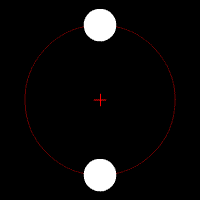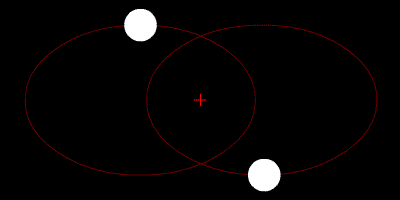One of the things I like about writing is that it takes you to domains you wouldn’t normally visit. During my research for my WIP, I came across many subjects, including sword fight, anatomy, medicine, geology, etc. One of the subjects I’d never imagined I would touch was astronomy. I’d always pegged space as a subject for the science fiction genre, and not fantasy.
It all started when I decided to place a second Sun in the sky. This sun needed to be dark and “demoralizing deep orange”. My MC would wake up every day to a bright orb and its dark companion. The people of my world would hold one as a metaphor for life, light, and happiness, and the other for darkness and evil. So far everything was poetic. Then popped the famous question: Was it realistic? And this question branched into others.

Photo Credit: NASA/Tod Strohmayer (GSFC)/Dana Berry (Chandra X-Ray Observatory)
Do binary star systems exist?
They do. Not only that; systems with five stars also exist. According to this article, “More than four-fifths of the single points of light we see in the night sky are actually two or more stars orbiting together.”
How do they work?
Stars are gigantic masses, and like everything else that exists, they have gravitational pulls. If two stars are close to each other without orbiting, they pull together, and eventually collide, and hopefully fuse into one. But this was definitely not what I was interested in. In order for two stars to survive, they need to orbit each other. There should always be a momentum that defies gravity. The International Space Station constantly travels at 17,130 mph around the earth, and that’s why it doesn’t crash into the atmosphere. And that’s why we don’t feel gravity up there, though the Earth’s pull is still 90% as strong as it is on the surface.
Depending on their relative size and speed, their orbit can look different. If one star is much smaller, it can act as a satellite around the bigger star. But as my two suns needed to be the same size, these were the scenarios I needed to consider (animations are from the Wikipedia page on Binary Stars):


The first scenario, which is the easiest, and which is the one I chose, is when the two stars are fast enough to completely counter gravity. The second case happens when the stars don’t initially have enough momentum, and pull together. But the momentum builds as they approach, and by the time they almost crash, they drift away from each other, and this repeats in a cycle. This kind of orbit can be exotic if you can wrap your head around the implication on the exoplanet that orbits the pair. I couldn’t! Because the orbit of the planet around this setup is weirder than the setup itself. I’ll show you simulations at the end.
Can we have hot and cold together?
This was the question that worried me the most. So, we have two stars, and they orbit in a nice stand-off. But why would they be different? One would think they would be parts of the same matter, separated during formation.
Luckily I found that hot-and-cold binary stars also exist. Antares and Antares B in the constellation of Scorpius are such system with a red giant and “main sequence” star. I also found out that bodies that are close to each other do not even have to be of the same matter. This is the space we are talking about. The moon is constantly drifting away from the earth. At some point it’s going to free itself from our gravitational force, and wander into space. It might become a moon to another planet or, most likely, crash into one.
You’ve probably heard of the galaxy “Andromeda”. But did you know that Andromeda is in collision course with the Milky Way? In about 4 billion years, the two galaxies will collide. Think of enormous stars and planets aimlessly tossed into our galaxy. Scary. But there will not be only destruction. New systems will form in the process. Two stars that pass each other during the event might be lucky enough not to collide, but be caught in each other’s gravitational pull, and have just the right momentum to orbit each other happily ever after.
What is the nature of my dark star?
Red giants are stars that are near the end of their lifetimes. They are red, which fits the description of Diva (my dark and cold star). But Diva could never be a red giant. Red giants are at their most unstable state. They inflate because their cores are shrinking, and it cannot pull their own masses together. And they are neither dark nor cold. They are red, but very bright. Their surface is relatively cold, but the star itself keeps getting hotter as it reaches the end of its life. So, all this deviates from my idea of Diva.
To make maters worse, put this decomposing piece of rock in front of a healthy star. It will keep shedding its surface toward the other star, and thus two distinctive orbs will not be what the residents of my world will see. It will most likely be a bright orb, and a red ungainly cloud.
This was depressing. But then I learned about red dwarves, or “failed stars”. These stars are small, cold, and dark. Perfect! Size could be a problem here (it always is!). The biggest known red dwarf has only half the Sun’s mass. But that was the closest thing I’d found to something realistic. So, I just placed my planet closer to the pair. Both stars would be half the Sun’s size, which would be all right because my planet is also closer to them.
How do planets work in these systems?
Now that we have two stable stars orbiting each other that don’t die immediately, we need to place our planet in the system. Where do we place it? Between the two stars? Outside? How far out?
Our planet is by definition a circumbinary planet, and by nature a neglected child. Turns out binary star system really don’t like planets, and the chances of transit for a planet is higher in these systems. This video shows a binary star system with a couple of planets in simulation:
I was laughing the whole time as I watched planets shoot out of orbit one by one. Even those that stay in orbit have strange paths. The orbit twists and rotates all the time, and the shape is not even circular or elliptical. Imagine building a world around this setup. Seasons would depend not only on what time of year it is, but also what year!
Summer? That was a hundred years ago!
A history book would define Diva and Hita sitting alongside each other. Now, my hero looks at the sky and she sees that they are vertically aligned. The orbit is turning. This world simply doesn’t work. Can there even be life under such conditions? How long would it last until the planet shoots out?
That’s when I came across a simulation algorithm. I made it into a planetary system simulator, and began experimenting with different setups. It took me days until I found one that worked. The orbit was stable, the planet and the suns were sticking to their courses, and the planet was far enough to support life (at least with a little fictional flavor).
What are the implications on the planet?
Now, let’s get to how life on the planet looks like. You can watch and experiment on different planetary setups if you go to the simulations I’ve provided at the end of this post.
Suns in the Sky
When the idea first formed in my head, I thought the two stars would always be at the same distance from each other from the point of view of an observer on the planet. But the truth is that the planet is orbiting here. There are times when one star eclipses the other. I got creative with this fact. I even named those events as special days in the world’s calendar system. The “dark fusion” and the “bright fusion”. Turned out we had two of each every year. Dark, bright, dark, bright. The two suns drift away after each of these events, and then come together for the next one.
Seasons
They are non-existent in this world, as we have rapid changes between warm and cold, four times a year. And with a roughly circular orbit, it’s impossible to have seasons the way we have them on Earth. But this is a problem. How do flowers bloom? How do animals survive?
The Earth’s rotation axis is not perpendicular to its orbit around the sun. It has a tilt, and that’s one of the reasons we have colorful seasons. This, I could place in my world. I place the tilt in a way that during the second dark fusion, the northern hemisphere would be freezing cold, and during the other one it would be a little bit milder. Bright fusions would be warm and cozy.
A year in this world is 212 days and, thanks to the setup I found, the events are split evenly across this period. We don’t even have leap years. Instead of seasons or months, we have cycles. I was tempted to still call them seasons for convenience, but season paints the wrong picture in the reader’s mind.
Weather
During the dark fusion, Diva doesn’t let the light of Hita get through, so, it will be cold. During the second dark fusion, when the northern hemisphere is facing away, it will be even colder.
But life doesn’t have to be exactly like it is on the earth. Plants in my world are all ever-green, and obviously I don’t ever mention it, because it’s a given. They’re also tenacious enough to withstand dark fusions.
Only the area surrounding the equator is habitable in this world.
Time for some fun!
Following are some of the simulations I did until I got the system right. You can change the parameters to see how it affects the system. (Hit the orange “Rebuild” button at the top after each change):
- Attempt 1: Stars are stationary, and they collide.
- Attempt 2: Planet can’t decide which star to orbit.
- Attempt 3: Planet goes haywire.
- Attempt 4: Eccentric corotation; planet develops a love/hate relationship.
- Attempt 5: Almost right; too regular.
- Attempt 6: The world is born!
Last Word
I hope you enjoyed this post. If you have any questions, found anything inaccurate in this post, or have anything you want to share with me, you can leave a comment here, send me an email, or find me on Twitter. The simulator included in this post is part of a bigger project called “World Forge”. It is a world building tool that helps writers keep track of their worlds, their characters, and the events in their stories.
The project is still in the beta stage and registration through the website is not possible. I could use some help to improve it to better fit writers’ needs. If you want to support the project, drop me a line and I will provide you with a free account.
Happy Writing!